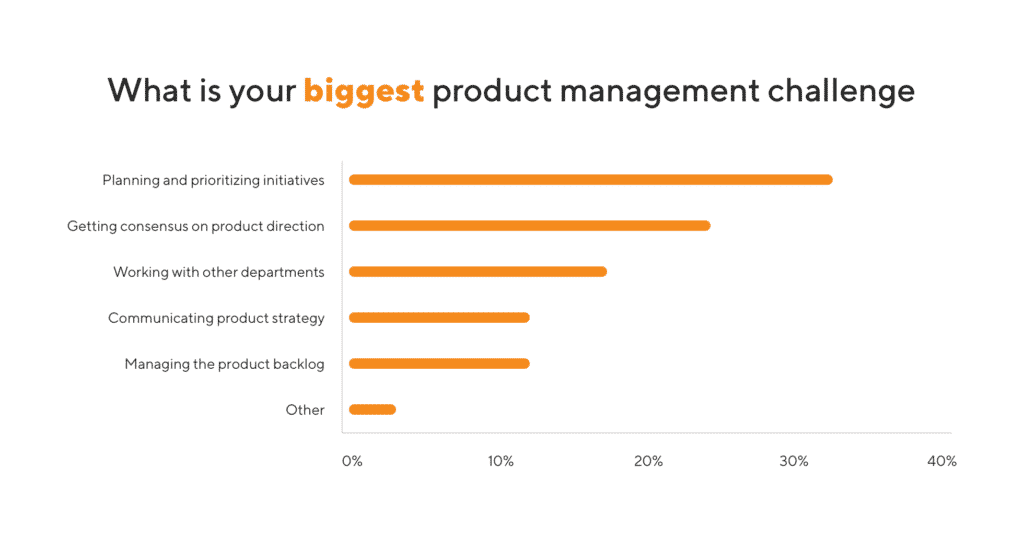A defined prioritization framework can help making tough decisions a bit easier.
Prioritization is challenging. In our latest Product Planning Report, 32% of product managers said their biggest product management challenge is planning and prioritizing initiatives. Product professionals are continually balancing resources, expectations, customer requests, technical debt, and more.

As your organization’s central hub for your products, a defined prioritization framework can help make these tough decisions a bit easier.
Furthermore, having a defined prioritization framework is extremely useful when it comes time to defend your product roadmap. There will always be outliers and one-off projects, but when all prospective features get the same prioritization treatment, it makes it harder for one person or team to derail your product strategy.
In this chapter, we’ll address a few general pointers for roadmap prioritization and outline a few prioritization frameworks you may want to consider.
General Tips for Roadmap Prioritization
Regardless of the prioritization method you choose, here are some suggestions for thinking through which initiatives to include on your roadmap:
- Approach prioritization as a team activity. Not only does it create buy-in on the team, but also you get different perspectives. And, it’s also a lot more fun.
- Limit the number of items you are prioritizing. Focus on the biggest items rather than the small details.
- Categorize and group initiatives together into strategic themes (for example, “improving satisfaction” for a particular persona would be a good way to group).
- Before you begin prioritizing initiatives, it’s helpful if you understand the customer value for each initiative. The customer value should be rooted in evidence that you’ve gathered from customers rather than your opinions.
- Start with a rough estimate of the cost for each item. Even T-shirt sizing of “small,” “medium” and “large” will be helpful during the process.
Product Roadmap Prioritization Frameworks
Here are several other ways to quantify the many variables among the features, enhancements, fixes, and other items competing for the limited resources in your product roadmap.
Quantitative methods for prioritizing features
Quantitative prioritization methods are great for doing some initial prioritization on your own before presenting your findings to a larger audience. They can also guide your product strategy conversations so that it won’t be dictated by opinion alone.
Value vs. complexity quadrant
In the Value vs. Complexity model you evaluate every opportunity based on its business value and its relative complexity to implement. The matrix is simple: The initiatives that have the highest value and the lowest effort will be the low-hanging fruit for your roadmap.
Weighted scoring (or benefit vs. cost)
With weighted scoring you can use the Value vs. Complexity model, but layer in scoring to arrive at an objective result. By using a scoring method to rank your strategic initiatives and major features, product managers can facilitate a more productive discussion about what to include on the product roadmap.
Kano Model (customer delight vs. product function)
With the Kano model product managers can look at potential features through the lens of the delight a feature provides customers vs. the potential investment you make to improve the feature.
Qualitative methods for prioritizing product initiatives
Qualitative prioritization methods often represent great opportunities to work cross-functionally on prioritization. As you’ll notice, a few of the methods that follow lend themselves well to collaborative activities.
MoSCoW analysis
The acronym, MoSCoW, stands for four different categories of initiatives: must-haves, should-haves, could-haves, and will not have at this time (or sometimes “wish”). First, key stakeholders and the product team need to get aligned on objectives and prioritization factors. Then, group your list of proposed features into the four MoSCoW buckets. With such limited options, it usually becomes clear which initiatives are truly a top priority.
Buy-a-Feature
Buy-a-Feature is an activity you can use with customers or stakeholders to prioritize a set of potential features. The approach is simple but fun. List potential features and assign a “price” to each (based on a relative cost to develop it). Hand out a set amount of cash and then ask participants to buy the features. Some will place all their money on one particular feature they’re passionate about, while others might spread their cash around the room. The result is your prioritized feature list.
Opportunity scoring
Opportunity scoring is a type of gap analysis that comes from outcome-driven innovation. Without getting too detailed, the idea is to measure and rank opportunities based on their importance vs. customer satisfaction. To conduct opportunity scoring you ask customers to score the importance of each feature and then also score how satisfied they are currently with that feature. Your opportunities are those features that are highly important yet customers gave a low satisfaction score.
Affinity grouping
Affinity grouping can be a fun prioritization activity. The idea is simple: have everyone brainstorm opportunities on sticky notes. Then as a team, begin to group similar items together, and name the groups. Finally, everyone on the team begins to vote on or rank the groups.
Story mapping
Story mapping is a great way to document the MVP by organizing and prioritizing user stories. The idea, in a nutshell, to create task-oriented story cards, group them together, then arrange the cards in priority order for each group. The final step is to draw a line (often with tape) across all the stories to divide them into releases/sprints.
Three Things to Remember About Prioritization
Before we move on and discuss actually building the roadmap, there are three things you want to keep in mind about prioritization.
- Your prioritization framework is always a moving target. While it’s important to define how you will prioritize, it’s also important to understand that it will most likely evolve over time.
- Prioritization should be a team exercise. Your colleagues outside of the product department have valuable insights into your users and market.
- Prioritization is only as good as your ability to communicate it. You should be able to use your prioritization methods to answer “why” and defend your product strategy.